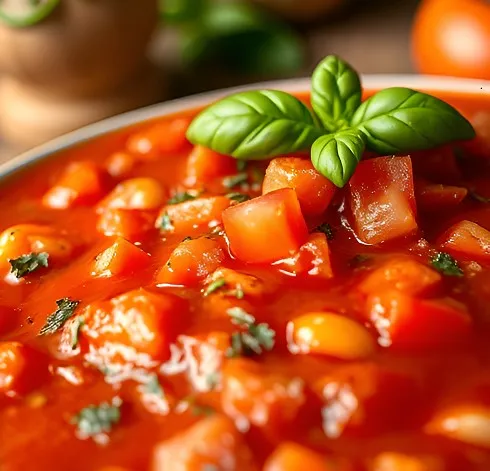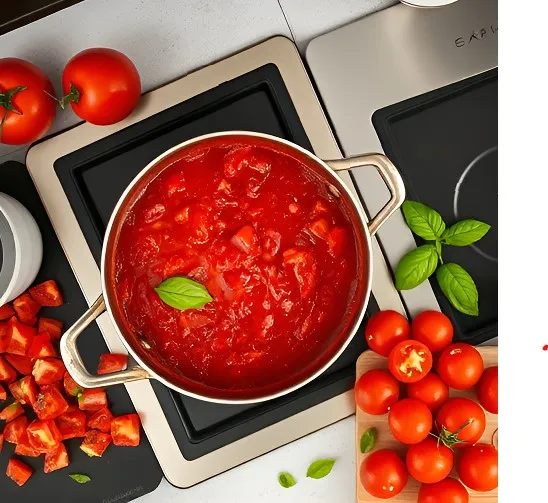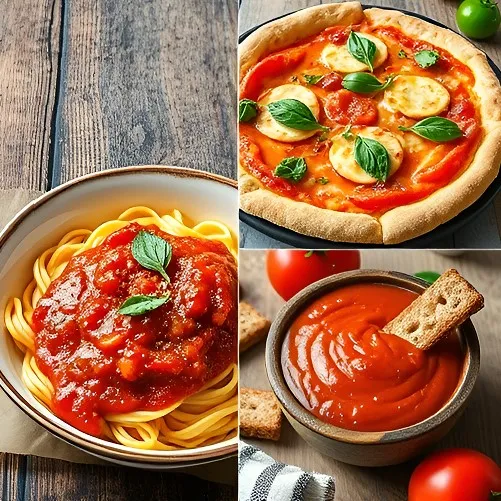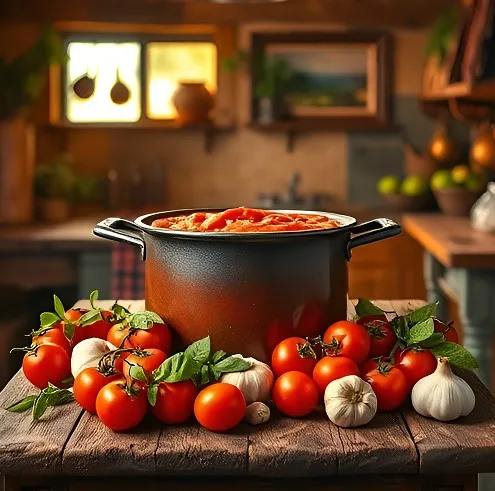Few scents in the kitchen evoke as much comfort and joy as the simmering aroma of a homemade marinara sauce. It transports you to sun-drenched Mediterranean coastlines where tradition meets passion in every vibrant, bubbling pot. Whether you’re a seasoned cook or just starting your culinary journey, the story of marinara is one of simple ingredients turned magical through thoughtful preparation. In this article, we’ll explore the historical roots of marinara, break down its essential ingredients, and dive into creative variations and modern twists—all while ensuring that every detail elevates your cooking experience.
What Exactly is Marinara Sauce?
Marinara sauce is much more than just a tomato base—it’s a celebration of a few high-quality ingredients coming together to create a dish that is both fresh and versatile. At its heart, marinara is built on tomatoes, garlic, olive oil, and a medley of herbs. The resulting flavor profile is light yet robust; the sauce highlights the natural sweetness and tang of tomatoes, creating a balanced blend that can enhance an array of dishes.

One common misconception is to conflate marinara with pizza sauce. Although both begin their life with a tomato base, they diverge quickly in consistency, cooking time, and flavor intensity. Marinara sauce is typically thinner and cooked for a shorter period than pizza sauce, ensuring that the individual notes of garlic, herbs, and tomato shine through without being overshadowed by heaviness or excessive concentration. This makes marinara a versatile companion not just for pasta, but also as a dipping sauce, a base for stews, or even a topping for freshly baked bread.
The Essentials: Ingredients That Ignite Flavor
The secret to an unforgettable marinara lies in the selection of ingredients. When each component is chosen with care, the resulting sauce bursts with flavor and complexity despite its simple composition. Here’s a closer look at these core ingredients:
Tomatoes
The foundation of any good marinara sauce is, of course, tomatoes. For the best flavor, opt for San Marzano tomatoes—a variety grown in Italy that is renowned for its natural sweetness and low acidity. Whether you use canned or fresh tomatoes, their quality sets the stage for the depth of flavor that follows.
Garlic
A few cloves of garlic provide not only robust flavor but also a tantalizing aroma that fills the kitchen. Lightly sautéing the garlic in olive oil before adding the tomatoes releases its rich, pungent essence, creating a fragrant base that prepares your palate for what’s to come.
Olive Oil
Extra virgin olive oil is indispensable in a classic marinara recipe. Its silky texture and complex flavor will merge with the garlic and tomatoes, enhancing every aspect of the sauce. A high-quality olive oil can make all the difference between an ordinary dish and a sublime culinary delight.
Herbs
Fresh basil and oregano are the heart of the marinara’s herbaceous finish. These herbs, added either during cooking or at the end of the process, impart a brightness that balances the acidity of the tomatoes. For added depth, a sprinkle of thyme or parsley can also be introduced, depending on your personal preference.
Optional Accents
Many cooks like to experiment with extra ingredients to tailor their marinara to specific dishes. Some of these include:
- Red Pepper Flakes: A dash for those who prefer a spicy kick.
- Onions: A finely chopped onion can add natural sweetness and complexity.
- Red Wine: A small splash can introduce a subtle layer of richness.
- Celery or Carrots: Occasionally, these vegetables are used to round out the flavor, especially in family recipes handed down through generations.
When every ingredient is fresh and thoughtfully combined, the result is a truly elevated sauce—one that captures the spirit of Italian authenticity while adapting to the varied needs of modern cuisine.
Mastering the Craft: A Step-by-Step Guide to Homemade Marinara Sauce
Transforming simple ingredients into a vibrant marinara sauce may seem daunting at first, but it’s a process that invites creativity and personal flair. Follow these steps to create a pot of marinara that will become the cornerstone of your kitchen repertoire:
1. Heating the Olive Oil
In a large, heavy-bottomed saucepan, gently heat a generous drizzle of extra virgin olive oil over medium heat. The oil should warm enough to release its aromas without reaching the point of smoking. This step is crucial, as a well-heated pan preps the next ingredients perfectly.
2. Sautéing the Garlic
Once the oil is warm, add minced garlic into the pan. Allow it to sauté for a very brief period—about 30 seconds—as you want it to soften and infuse the oil without burning. Burnt garlic can introduce bitterness, which would be a detriment to the overall balance of the sauce.
3. Introducing the Tomatoes
Time to add the star of the show! If you’re using canned tomatoes, consider gently breaking them down by hand or with a spoon as you add them. Fresh tomatoes need a bit of work: peel if desired, chop roughly, and add them to your simmering creation. The transformation from a chunky tomato mixture to a smooth, rich sauce happens gradually.
4. Seasoning and Simmering
Now comes the fun part: seasoning your sauce. Add salt and freshly ground black pepper, along with any optional spices you wish to incorporate—think red pepper flakes for heat or even a splash of red wine for an added layer of flavor. Reduce the heat and let the sauce simmer gently for 20 to 30 minutes. This simmering period allows the flavors to meld and the tomatoes to break down further, yielding the perfect consistency. Stir periodically to ensure nothing sticks to the bottom.
5. Finishing with Fresh Herbs
Just before serving, fold in your chopped basil and oregano. These fresh herbs, added at the end of the cooking process, retain their bright flavors and vibrant aromas, giving your marinara an irresistible lift right before it hits the table.
Each of these steps builds upon the previous, resulting in a sauce that is as nuanced as it is straightforward. Whether you’re preparing a quick weeknight meal or a special dinner for guests, homemade marinara delivers warm, hearty comfort in every spoonful.
Exploring Variations: Putting a Personal Spin on a Classic
The beauty of marinara sauce is its versatility—it welcomes innovation while always remembering its Italian roots. Once you’ve mastered the classic version, there are countless ways to customize the recipe to suit your taste or adapt to different dishes.
Spicy Marinara
For those who enjoy a bit of a fiery kick, introduce a good helping of red pepper flakes early in the cooking process. The spice mellows as it simmers, marrying perfectly with the tangy tomatoes and aromatic herbs. This variation is perfect for drizzling over pasta or even as a base for a spicy shakshuka.

Chunky Marinara
Some cooks prefer retaining a rustic, hearty texture in their sauce. To achieve a chunky marinara, skip the blender and leave the tomato pieces larger. This approach not only adds visual appeal but also provides delightful bursts of flavor that stand out beautifully in dishes like baked pasta or as a robust topping for crusty bruschetta.
Creamy Marcara
For an indulgent twist, stir in a splash of heavy cream or a pat of butter at the very end of the cooking process. This method softens the acidity of the tomatoes and yields a richer, silkier sauce. Creamy marinara works exceptionally well with delicate pasta shapes and can transform a simple dish into an upscale culinary experience.
Vegetable-Infused Marinara
Adding extra vegetables can elevate the nutritional value of your sauce without sacrificing flavor. Consider incorporating diced mushrooms, bell peppers, zucchinis, or even spinach. These ingredients introduce an extra layer of complexity and serve as an excellent way to pack more vitamins and minerals into an everyday meal.
When experimenting with these variations, remember that balance is key. Each additional ingredient should complement, not overpower, the inherent freshness of the tomatoes, ensuring that the overall flavor remains harmonious.
Beyond Pasta: Creative Ways to Use Marinara Sauce
Marinara sauce’s appeal lies not only in its straightforward flavor but also in its undeniable adaptability. Its vibrant character makes it a star in a variety of dishes, far beyond the realm of your standard pasta dish.
Imagine starting your culinary adventure with a homemade pizza that bursts with flavor and freshness. Instead of relying on processed sauces, spread your hand-crafted marinara as the pizza base. The sauce’s lighter consistency allows the crust to remain crisp while the harmonious blend of herbs and tomatoes melds perfectly with melted cheeses and your favorite toppings.

For another creative application, consider serving marinara as a delectable dip. Whether paired with breadsticks at a party, as an accompaniment to mozzarella sticks, or even alongside crispy fried calamari, its bright, tangy profile adds a gourmet twist to any appetizer spread. It’s a dish that not only caters to casual snacking but also provides an upscale touch to entertaining guests.
In the realm of casseroles, marinara shines as the adhesive that brings various elements together. It can serve as a binding layer in lasagna, adding moisture and flavor, or serve as a comforting base in eggplant Parmesan, transforming every bite into an explosion of tomato, garlic, and herb goodness. For busy home cooks, having a ready-made batch stored in your freezer means that a delicious meal is never more than a few minutes away.
If you’re hosting a dinner party or simply want to impress your family, consider using marinara as a poetic sauce over meatballs. It offers a light yet flavorful contrast to the richness of the meat, complementing the savory elements with its freshness. Even more, layering marinara over a bed of roasted vegetables or drizzling it atop a grilled sandwich can bring a burst of color and flavor to your presentation, making everyday meals feel extraordinary.
Nutritional Benefits: Why Marinara is a Health-Friendly Choice
While flavor is paramount, the health profile of your food is just as important. Marinara sauce checks multiple nutritional boxes without compromising on taste. Its fundamental ingredients are not just chosen for flavor but also for their numerous health benefits:
Low in Calories:
A serving of marinara sauce is typically low in calories. This makes it an excellent choice if you’re looking for a guilt-free way to enhance the taste of your meals. Unlike richer, cream-based sauces, marinara is light and refreshing.
A Rich Source of Antioxidants:
Tomatoes contain lycopene—a powerful antioxidant that may help protect cells from damage. In addition to lycopene, tomatoes provide vitamins A and C, both of which support a healthy immune system and contribute to overall wellness.
Heart-Healthy Fats:
The inclusion of extra virgin olive oil ensures that your marinara is also delivering beneficial fats. Olive oil is known for its heart-friendly properties, including its potential to help regulate cholesterol levels and support cardiovascular health.
The marriage of these ingredients not only results in a superb tasting sauce but also appeals to those who value nutrition and a balanced diet. Marinara sauce serves as a reminder that healthy eating need not be bland or overly restrictive—instead, it can be a celebration of flavors, colors, and wholesome ingredients.
Storing and Reheating: Keeping Your Marinara Fresh and Flavorful
One of the practical advantages of making your own marinara sauce is its convenience when it comes to storage. With a little planning, you can ensure that your batch of marinara sauce remains just as delicious days and even months later.
Refrigeration:
Once your sauce has cooled to room temperature, transfer it into an airtight container and store it in the refrigerator. Properly stored, your marinara can remain fresh for up to five days. This makes it an excellent candidate for meal prepping—just reheat a portion, and your meal is nearly ready to serve.
Freezing for Longevity:
If you’ve made a large pot with visions of multiple meals, portioning your marinara into freezer bags or small containers is a smart move. When stored in the freezer, your sauce can maintain its quality for up to three months. When you’re ready to enjoy it, allow it to thaw gradually in the refrigerator or defrost it gently on the stove over low heat.
Reheating Without Losing Quality:
When it comes time to reheat, do so slowly on the stovetop to prevent overcooking. Sometimes, marinara may thicken during storage. A little splash of water or extra olive oil can help restore its vibrant consistency, ensuring that every bite remains as enticing as when it was freshly cooked.
Bringing Tradition Into Today’s Kitchen
Marinara sauce is more than just a recipe; it’s the embodiment of culinary heritage meeting modern-day simplicity. In today’s fast-paced world, where convenience often takes precedence, maintaining a connection with traditional methods can be both soothing and rewarding. Cooking marinara from scratch offers an opportunity: to engage in a meditative process that centers you, to honor time-honored recipes, and to ultimately create something that nourishes both the body and the soul.
With modern kitchen tools and a global palate at our fingertips, making marinara can be adapted into a variety of cooking styles. Some chefs slow-cook the sauce for extra depth, while others opt for the speed and efficiency required for weeknight dinners. Regardless of the method, the gentle simmering of fresh ingredients is a nod to a less hurried time—a culinary ritual that reminds us of the simple joys in food preparation.
Frequently Asked Questions About Marinara Sauce
What distinguishes a classic marinara sauce from other tomato sauces?
A classic marinara is characterized by a light and fresh tomato base, typically using San Marzano tomatoes along with garlic, olive oil, and a mix of fresh herbs. Unlike heavier sauces that require lengthy cooking times or incorporate meats and creams, marinara lets the purity and balance of its ingredients shine through.
Can I use marinara as a substitute for pizza sauce?
While both sauces share a tomato foundation, their textures and flavors differ significantly. Marinara is thinner, meaning it can be an excellent substitute in recipes like pasta dishes or as a dip. For pizza, however, you might prefer a thicker, more concentrated sauce to prevent the crust from becoming soggy.
Is marinara a healthy option compared to other sauces?
Generally, yes. With its low-calorie profile, beneficial antioxidants, and healthy fats provided by olive oil, marinara is a nutritious choice. It steers clear of the extra fats and sugars found in many meat-based or cream-based alternatives.
What are some creative twists I can try with my marinara?
From adding a spicy kick with red pepper flakes to introducing a creamy texture with a dash of heavy cream, marinara offers ample room for personalization. You can also try incorporating vegetables like mushrooms or zucchini to add extra depth and nutritional value.
Conclusion: Let Your Culinary Creativity Run Wild
Marinara sauce stands as a timeless example of culinary art that does not rely on extravagance but on a careful balance of simple, honest ingredients. Its story—from a humble sailor’s provision to an indispensable staple in modern kitchens worldwide—exemplifies the enduring power of tradition transformed through innovation.

